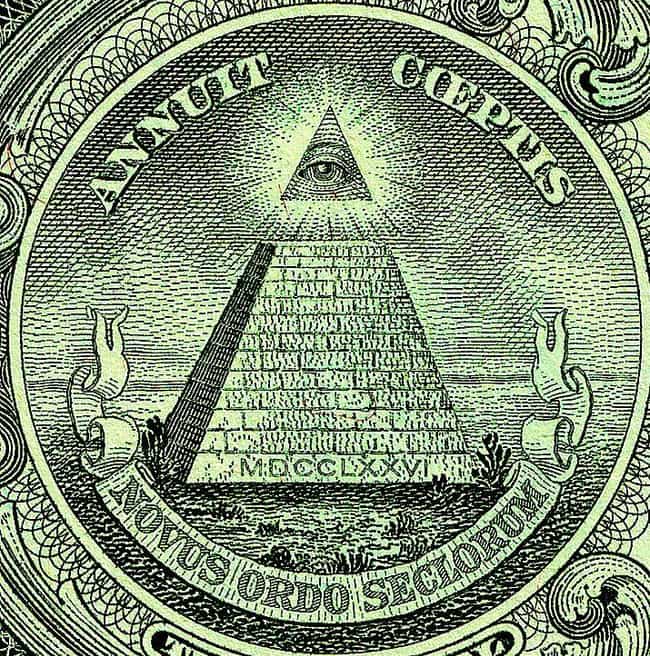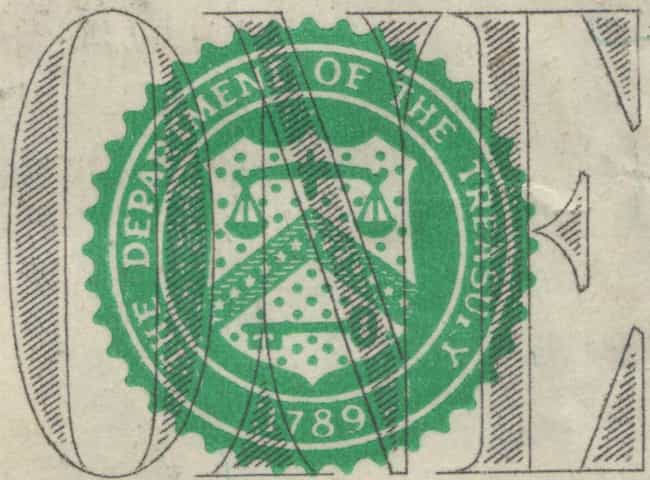There’s no doubt the US $1 bill is highly controversial. It’s the most talked about of all bills, and that’s not just because George Washington’s face replaced Salmon P. Chase, the Secretary of the Treasury, who originally adorned the bill (rude). Rumors circulating over the years have alluded to the Illuminati – a secret society originating from Bavaria – and the Freemasons having planted multiple meanings within the bill, while other traditional American values displayed upon it have become quite convoluted over the decades.
But what do these hidden symbols really mean? Their original meanings have been reinterpreted hundreds of times and have come out, well, messy to say the least. Whether you want to call that mess the web of conspiracy theories that circulate around the dollar is your own prerogative. The secret symbols of the dollar bill might be suggestive of a secret society that overshadows the government but they may also signify good ol’ fashioned American pride.

Official Explanation:
The Eye of Providence, also known as the all-seeing eye of God, symbolizes God watching over humanity. It is perhaps the most haunting symbol on the American dollar bill, and certainly the most talked about. The eye is situated in a triangle with rays of light emanating from it. Above it is a Latin motto that translates to “Providence Has Favored Our Undertakings.” According to Thompson, it “alludes to the many signal interpositions of providence in favor of the American cause.”
What People Think It Really Means:
Many conspiracy theorists are convinced that the Eye of Providence is a reference to the order of the Freemasons. Many have also pointed out its striking resemblance to the symbol of the Illuminati. Despite this, the eye in the triangle was a common symbol for the Holy Trinity at the time and, in a predominantly Christian society, it would have made sense to design the dollar bill accordingly.
It was President Franklin Roosevelt and Henry Wallace, the Secretary of Agriculture, who decided to start printing the Great Seal on paper money in 1934. Coincidentally, they were both Freemasons and favored the design due to its reference to the Masonic symbol of the Great Architect of the Universe. Others would argue that the Freemasons didn’t start using a similar symbol until 10 years after the first Washington was printed – Not to mention, the design itself wasn’t created by a freemason.

Official Explanation:
Below the Eye of Providence is an unfinished pyramid, which according to Thompson [Charles Thompson, Secretary of the Continental Congress, 1774-1789] signifies “strength and duration.” The number thirteen reappears here in the number of rows, under which appears the number 1776 in Roman numerals, or the year the US officially established its nationhood.
What People Really Think It Means:
According to Bill Ellis, a professor of American Studies at Pennsylvania State University, the pyramid signifies human structures that have lasted throughout the ages. As mentioned before, the pyramid and eye didn’t have their own place until FDR removed it from the other half of the Great Seal in 1935. Roosevelt also liked the ring of a “new world order,” to go along with his New Deal.
The folklorish undertones here signaled to conspiracy theorists that the US government had been taken over by evil spirits. Other creative decodings of the pyramid and eye include the traces of a hexagram that imply even deeper meanings.
There Might Be Latin Numerals Disguised As 666

Official Explanation:
The Latin inscription below the pyramid that reads “Novus Ordo Seculorum” translates to a “New Order of the Ages.” This refers to the new form of government that was being established at the time or a “new American era.” “Annuit Coeptis,” above the pyramid roughly translates to “endeavors are favored.”
What People Really Think It Means:
Just like nearly everything else on this list, the meaning behind these Latin phrases and numerals have become misconstrued over the centuries. For example, some creative theorists have pointed out that if you take the M, C, and X out of out of the Roman numeral MDCCLXXVI below the pyramid, it refers to “666.” Others have reinterpreted the translation of ‘Annuit Coeptis’ to mean “announcing conception,” and ‘Novus Ordo Seculorum’ as “secular.”

Official Explanation:
One of the most notable symbols on the front of the US one dollar bill is the modern seal of the US Treasury. It consists of a few notable symbols itself including a balance, a key, and thirteen stars in the shape of an upside down V. Contrary to popular belief, the balance represents justice rather than a balanced budget – a task handled by congress, not the treasury. The key symbolizes authority and the chevron’s thirteen stars represent the thirteen original colonies.
What People Think It Really Means:
To understand history is to understand the present. Any American who knows anything about history, knows the remnants are noticeable – that is, if they haven’t already been covered up. The US Treasury seal that adorns the one dollar bill didn’t always look the way it does now. The original design by Francis Hopkins was first issued in 1862, with close attention to symbolism. It was decided that the spikes surrounding the seal should equal the number of states in the union, which was 34 until the start of the Civil War when 11 states seceded from the Union. Despite this, members of the treasury saw the division as temporary and went through with the design.

Official Explanation:
Charles Thompson first presented his design for the Great Seal of the United States in 1782. The symbolism behind each detail signifies traditional American values. The eagle, with its wings spread in valor, is adorned with loads of symbolic memorabilia. On its breast is a shield that consists of two parts – a band across the top representing Congress, and 13 vertical stripes in honor of the 13 original colonies. In its left talon the eagle is holding thirteen arrows, representing war and in its right talon, an olive branch to signify peace. The banner above the eagle is a Latin phrase which translates to “out of many, one” while the thirteen stars represent a new constellation taking place in the universe.
What People Really Think It Means:
The eagle didn’t always look the way it does now. Between 1801-1807 the symbols being held by the eagle were in reverse order and were being printed on the silver coin. You might not think much this, however in the language of symbols the right side signifies dominance. Many European journalists and diplomats took to their pens and condemned – what they interpreted to be – America’s belligerence and eagerness to insinuate war. In light of their accusations, the design was recreated in 1807 until the War of 1812 soon diminished the upgraded eagle’s peaceful efforts.

Official Explanation:
In 1956 the US national motto became “In God We Trust” and a law was passed by Dwight Eisenhower that it be printed on American currency, but it wasn’t officially in circulation until 1957. Although it had been previously printed on coins, during the Cold War era when antireligious sentiment’s from the Soviet Union were running rampant, the US government found it essential to reiterate American values.
What People Really Think It Means:
Certain groups and people see this over-arching motto as non-representative of such a diverse nation. In light of its religious sentiment, they have pointed out its violation of the Establishment Clause of the First Amendment, or freedom of religion. These people would like the phrase removed from US currency considering it’s a public entity.

Official Explanation:
This one might take some binoculars, but if you look closely there appears to be the outline of an owl perched right above the large “1” in the top right hand corner. Others have interpreted it as a spider within a web. Either way, this one has little official meaning but a lot of speculation surrounds the mysterious creature.
What People Really Think It Means:
Conspiracy theorists who see an owl consider this yet another trace of the Masons and/or an anti-counterfeit device. Others see it as a spider and therefore evil or satanic. Either way, this mysterious little creature has fueled many conspiracy theories over the years.

Official Explanation:
The number 13 has appeared many times on the dollar bill. For example, there are 13 steps on the pyramid, 13 stars above the eagle, 13 horizontal and 13 vertical stripes on the shield, 13 leaves and 13 berries on the olive branch, while the eagle is holding 13 arrows in its talon. Officials claim that each instance of the number 13 represents the 13 original colonies.
What People Really Think It Means:
Does Friday the 13th ring a bell? Obviously, if 12 is the perfect number, 13 must be the most unlucky. Conspiracy theorists think the number 13 is highly unlucky, and in the context of the dollar bill, is suggestive of its satanic undertones.

Official Explanation:
The unfinished pyramid is meant to convey the idea that America’s growth is not complete. Only once the capstone is finally intact will America become the nation it’s meant to be. (When this will occur we can’t really say.)
What People Really Think It Means:
Some conspiracy theorists believe the number of bricks on the pyramid is 72. They have thus drawn conclusions that it is an Illuminati reference to the 72 powers of the name of God in Qabbalah. However, the task of counting these bricks is nearly impossible. The lines are simply too vague to confirm an exact number. The unfinished nature of the pyramid suggests the existence of a secret society operating a hidden agenda.

Official Explanation:
The Egyptian symbolism on the dollar bill represents longevity and resilience. It connects a young nation in the genesis of its establishment and roots it in the foundations of humanity.
What People Really Think It Means:
The connection between ancient Egypt and the origins of America are clear based on the design of the Great Seal, which contains a pyramid. However, had Thomas Jefferson and Benjamin Franklin had their way the seal might have featured an Egyptian Pharaoh. In addition, had it been up to Benjamin Franklin the national bird would have been the Turkey – a bird that’s native to the US.
(For the source of this, any many other equally interesting articles, please visit: https://www.ranker.com/list/meanings-of-symbols-on-dollar-bill/hannah-irvine/)










Why did they use Roman numetals?